Older adults without a child or partner are increasing across the globe but may not be “aging alone.” Childless and unpartnered older adults in Europe report more friends in their close network, particularly in more economically developed countries where friendship is considered “very” important in life. As countries transition demographically, friendship may become increasingly important for support.
Across the globe, nations are experiencing increased economic development and subsequent shifts in demography and culture (Inglehart and Baker, 2000). Of particular concern to aging scholars are declines in fertility and marriage, which have resulted in an unprecedented number of people aging without traditional family ties (Margolis & Verdery, 2017; Verdery et al., 2018). While terms like “kinlessness” and “aging alone” are frequently used to describe this growing population who receives less support (Grundy & Read, 2012), older adults without children or a partner may not be family-less or alone.
Although children and partners remain the most common source of support for older adults across the globe, this model is not universal to all individuals or societies. Extended family ties and friendships may play a crucial role in the social integration of older adults, with and without traditional families (Antonucci et al., 2010; Deindl & Brandt, 2017; Djundeva et al., 2018), and may act as “fictive kin.” Further, the extent to which older adults desire to rely solely on family ties for support as they age varies cross-nationally depending on societal norms, public and private resources available for aging care, and other factors. For example, economic development is correlated with declines in fertility and marriage (Lesthaeghe, 2014), decreased cultural emphasis on a family-centered model, increased individualism (Inglehart & Baker, 2000), and increased proportions of individuals who report friends are “very important” in life (Mair, 2013).
Therefore, older adults who do not have traditional family ties, particularly in countries that express a stronger emphasis on the role of friendship, may rely more heavily on friendship in their social networks. If so, it is important to reconsider how we conceptualize older adults’ social support options, how we measure these in our data sources, and how we design policy and programs aimed at promoting older adults’ well-being in a rapidly and aging world with changing family structures.
To my knowledge, this is the first study to examine this topic empirically using cross-national data. To do so, I rely on several data sources including the Survey of Health, Ageing and Retirement in Europe (SHARE, Wave 6, 2015) as well as the European Values Survey (EVS, 2011) and other sources of economic development data (e.g., World Bank, 2013). Using individual-level data from SHARE’s unique social network module of older adults’ confidant ties (people with whom they “discuss important matters”), I compare the count of friends in the networks of older adults with and without children as well as with and without spousal partners across 17 nations that vary in their emphasis on friendship (EVS). Figure 1 provides a descriptive summary of country-level data from SHARE and EVS that displays a potential correlation between number of friends listed in older adults’ networks (SHARE) and percent of people aged 18 and older in a nation that report friends are “very” important in life (EVS).
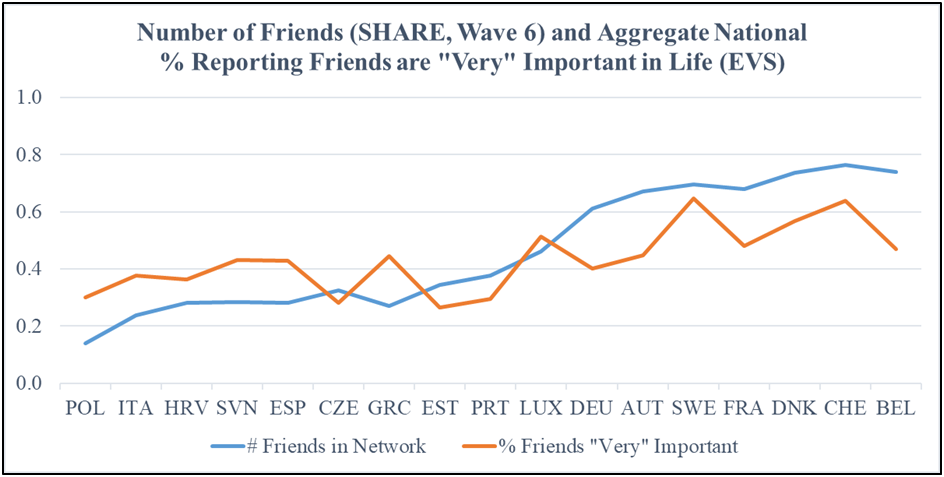
Although most older adults in SHARE list “0” friends in their confidant network, there is variation within each nation and across nations. Older adults in Poland (POL) are the most likely to report “0” friends in their confidant network and Poland also has the lowest national proportion who say friends are “very” important in life (less than 20%). On the other end of the spectrum, older adults in Sweden (CHE) report the most friends (approaching 1 friend per network on average) and Sweden also has a high proportion of people who say friends are “very” important in life (close to 80%). How do these patterns look after accounting for whether or not an individual has a child or has a partner, as well as their individuals’ characteristics (sex, age, education, employment status, income, health, and general network quality)? Figure 2 displays the predicted number of friends in the network of older adults in SHARE by their family structure and national emphasis on friendship.
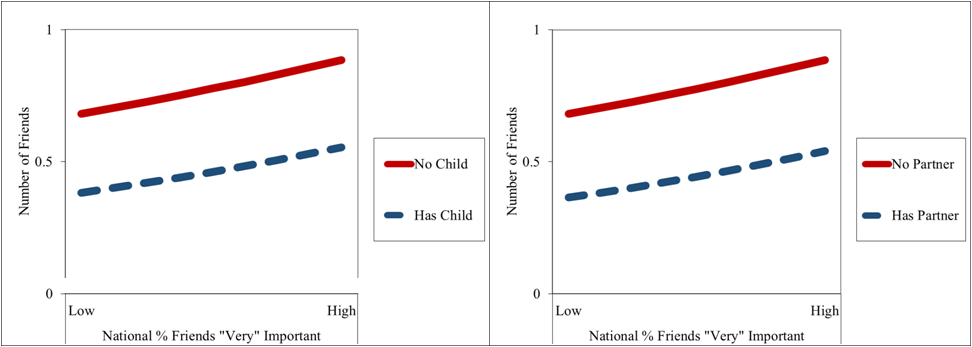
As suggested by previous literature, I find evidence in SHARE that older adults who do not have a child or who do not have a partner are more likely to report a friend in their network (red line) regardless of national context. Yet, older adults without traditional family ties who also live in nations with higher proportions of people who report that friendship is “very” important in life are the most likely to report a friend in their confidant network.
This study is a rather simple cross-national and cross-sectional exploration into older adults’ number of friends and the potential role of friendship in the lives of people across the globe, but it reveals a few messages that may become increasingly important for researchers and policy-makers to consider.
First, people who have fewer traditional family ties appear to have more friends. Therefore, although it is accurate to be concerned about their care options, we cannot assume they are socially “alone.”
Second, family structure (whether or not a person has a child or has a partner) may become an increasingly inaccurate empirical indicator of potential sources of support for older adults. Data collection efforts should follow SHARE’s lead and collect more nuanced data on older adults’ non-family ties.
Third, friendship patterns may shift with economic development. When I replicated the analysis using economic development as a national context measure instead of emphasis on friendship, the patterns were very similar. Perceptions of friendship are likely part of a larger “package” of economic development along with increasing individualism and changes in family decisions and thus demographic patterns. Policy-makers should consider these global shifts in planning (e.g., consider allowing friends to be listed as formal points of contact and benefits). Fourth, it is important to maintain a contextual lens in research and policy-making that incorporates not only political-economic considerations, but also socio-cultural norms. Being an older adult without a child or partner likely carries greater risk in some societies than in others. The greatest risk may be among older adults who are a severe demographic minority (e.g., childless or unpartnered in contexts where this is very rare and the policy system is designed around a family-centered model).
About the author:

Christine A. Mair, PhD, Associate Professor of Sociology, University of Maryland Baltimore County, Baltimore, USA
This article is based on:
Christine A. Mair: Alternatives to Aging Alone? “Kinlessness” and the Importance of Friends Across European Contexts, Journal of Gerontology: Social Sciences (2019), https://doi.org/10.1093/geronb/gbz029
Image source: Unsplash, photo by Val Vesa





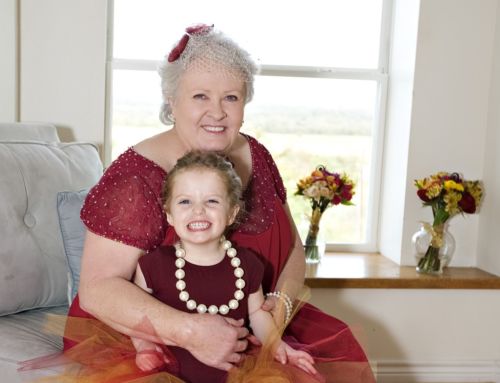
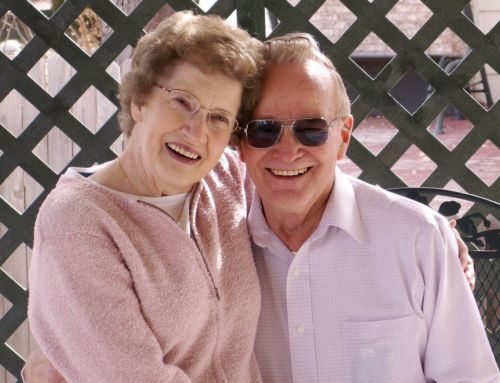
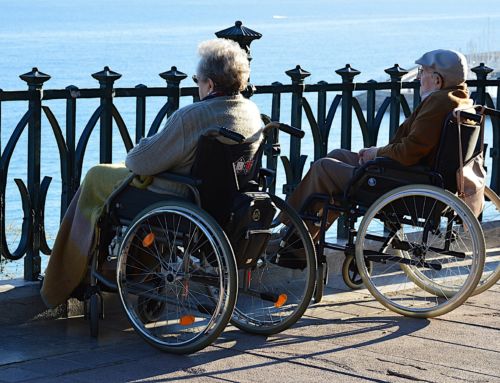

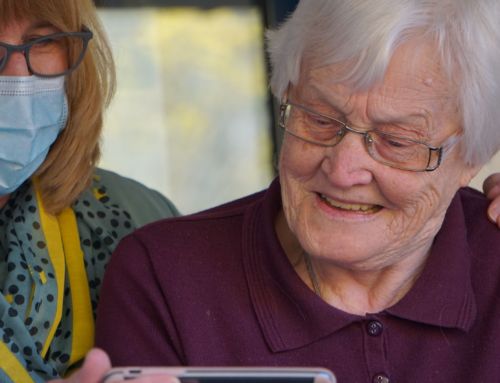
Leave A Comment Cancel reply